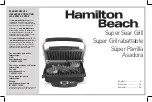
Safety, performance, and dependability have been given
top priority in the design of your percussion drill.
INTENDED USE
The percussion drill is intended to be used only by adults
who have read and understood the instructions and
warnings in this manual, and can be considered responsible
for their actions.
The percussion drill is intended to be used in drilling into
various materials, including wood, metal, and plastic using
a drill bit having a diameter of less than 13 mm. When in
impact mode, the percussion drill can be used in drilling
masonry and similar materials. When in screw driving
mode, the percussion drill can be used in driving screws.
Do not use the product in any way other than those stated
for intended use.
WARNING
Read all safety warnings, instructions, illustrations
and specifications provided with this power tool.
Failure to follow all instructions listed below may result in
electric shock,
fi
re and/or serious injury.
Save all warnings and instructions for future reference.
PERCUSSION DRILL SAFETY WARNINGS
■
Wear ear protectors when impact drilling.
Exposure
to noise can cause hearing loss.
■
Use auxiliary handle(s), if supplied with the tool.
Loss of control can cause personal injury.
■
Hold power tool by insulated gripping surfaces
when performing an operation where the cutting
accessory may contact hidden wiring.
Cutting
accessory contacting a “live” wire may make exposed
metal parts of the power tool “live” and could give the
operator an electric shock.
■
Hold power tool by insulated gripping surfaces,
when performing an operation where the fastener
may contact hidden wiring.
Fasteners contacting a
“live” wire may make exposed metal parts of the power
tool “live” and could give the operator an electric shock.
■
Do not operate on materials (e.g., asbestos) that
present a health hazard.
■
Switch off the product immediately if the bit stalls. Do
not switch on the product again while the bit is stalled,
as doing so could trigger a sudden recoil with a high
reactive force. Determine why the bit stalled and rectify
this, paying heed to the safety instructions.
The possible causes may be:
–
it is tilted in the workpiece
–
it has pierced the workpiece
–
the product is overloaded
■
Sawdust and splinters must not be removed while the
product is running.
■
When working in walls, ceilings, or floors, avoid
electrical cables and gas or water pipes.
■
Secure your workpiece with a clamping device.
■
Ambient temperature range for tool during operation is
between 0
˚
C and 40
˚
C.
■
Ambient temperature range for tool storage is between
0
˚
C and 40
˚
C.
■
The recommended ambient temperature range for the
charging system during charging is between 10
˚
C and
38
˚
C.
ADDITIONAL BATTERY SAFETY WARNINGS
WARNING
To reduce the risk of
fi
re, personal injury, and product
damage due to a short circuit, never immerse your
tool, battery pack or charger in
fl
uid or allow a
fl
uid to
fl
ow inside them. Corrosive or conductive
fl
uids, such
as seawater, certain industrial chemicals, and bleach
or bleach-containing products, etc., can cause a short
circuit.
■
Ambient temperature range for battery during use is
between 0
˚
C and 40
˚
C.
■
Ambient temperature range for battery storage is
between 0
˚
C and 20
˚
C.
TRANSPORTING LITHIUM BATTERIES
Transport the battery in accordance with local and national
provisions and regulations.
Follow all special requirements on packaging and labelling
when transporting batteries by a third party. Ensure that
no batteries can come in contact with other batteries
or conductive materials while in transport by protecting
exposed connectors with insulating, non-conductive caps
or tape. Do not transport batteries that are cracked or
leaking. Check with the forwarding company for further
advice.
RESIDUAL RISKS
Even when the product is used as prescribed, it is still
impossible to completely eliminate certain residual risk
factors. The operator should pay particular and additional
attention to these points in order to reduce the risk of
serious personal injury.
■
Injury to hearing – Wear suitable ear protection and limit
exposure.
■
Injury to sight – Wear protective eye shields or goggles
when using the product.
■
Injury caused by vibration – Limit exposure and follow
the instructions on risk reduction in this manual.
■
Electric shock after contact with hidden wires – Hold the
product only by insulated surfaces.
■
Respiratory injury from dust created by operating the
product – Wear suitable protection depending on type
of dust.
RISK REDUCTION
It has been reported that vibrations from handheld tools
may contribute to a condition called Raynaud’s Syndrome
in certain individuals. Symptoms may include tingling,
numbness and blanching of the
fi
ngers, usually apparent
upon exposure to cold. Hereditary factors, exposure to
cold and dampness, diet, smoking and work practices
are all thought to contribute to the development of these
symptoms. These are measures that can be taken by the
operator to possibly reduce the effects of vibration:
■
Keep your body warm in cold weather. When operating
the unit wear gloves to keep the hands and wrists
warm. It is reported that cold weather is a major factor
contributing to Raynaud’s Syndrome.
■
After each period of operation, exercise to increase
blood circulation.
■
Take frequent work breaks. Limit the amount of
exposure per day.
If you experience any of the symptoms of this condition,
1
English
|
EN
FR
DE
ES
IT
NL
PT
DA
SV
FI
NO
RU
PL
CS
HU
RO
LV
LT
ET
HR
SL
SK
BG
UK
TR
EL
Содержание 5133003595
Страница 82: ...80 ...
Страница 83: ...5 7 9 8 1 2 3 4 6 10 81 ...
Страница 84: ...20180306v1 82 1 2 1 2 4 ...
Страница 85: ...83 5 3 ...
Страница 118: ......
Страница 119: ......
Страница 120: ...961075442 01 Techtronic Industries GmbH Max Eyth Straße 10 71364 Winnenden Germany ...




































